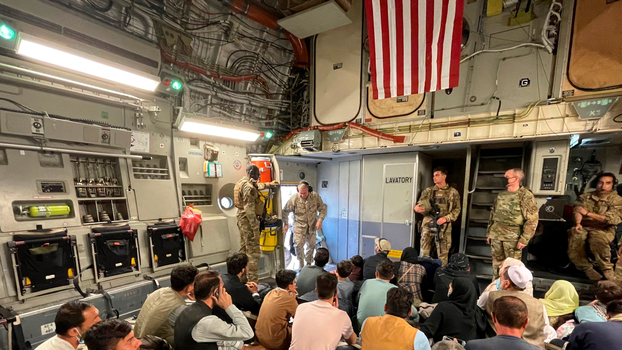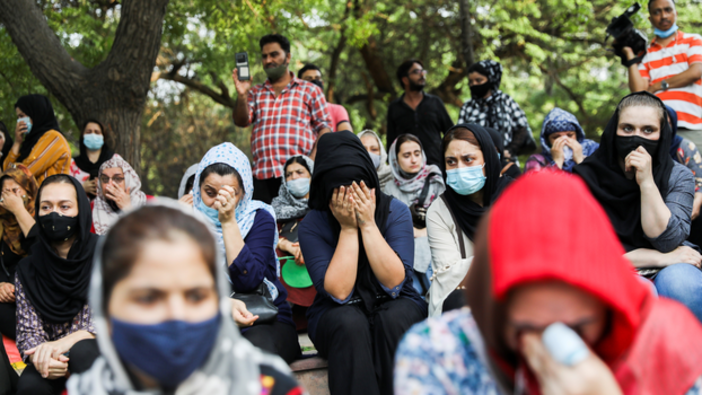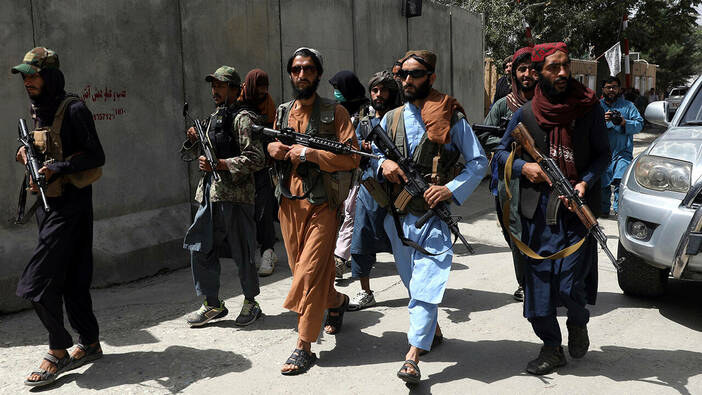
A decade after the end of actually existing socialism, George W. Bush, together with his neoconservative allies Dick Cheney, Paul Wolfowitz, and Donald Rumsfeld, hoped to bring the entire Near and Middle Eastern region—from the Caucuses to North Africa and from the Arabian Peninsula to the Hindu Kush—under US control as part of the Greater Middle East Initiative (GMEI). The attacks in New York and Washington on 11 September 2001 provided them with suitable grounds. With the Taliban regime internationally isolated, US fighter jets began bombing Afghanistan on 7 October 2001, eventually occupying the country. However, after 20 years and the deployment of up to 150,000 soldiers at certain times, the US and its NATO allies have not been able to permanently defeat the Taliban.
Matin Baraki was born in Shinah, Afghanistan near Kabul and is a political scientist and interpreter. He publishes mainly on the Middle East and Central Asia.
According to figures published on 22 March 2021 by the Statista Research Department, a total of 3,596 soldiers from the coalition forces—including some 2,500 US troops—lost their lives in Afghanistan between 2001 and 2020. Moreover, the cost of the war has been enormous—1.5 billion dollars per week at its peak between 2001 and 2014. In the long term, this would prove very difficult to finance. The US was eventually forced to acknowledge the limits of its military capacity and accept defeat.
Once the US Army had accepted that they could not beat the Taliban, Washington negotiated with them over the course of several years in Doha, the capital city of Qatar—secretly at first, then officially during the last two years. They signed an agreement in February 2020. In it, the US government pledged to withdraw its troops from Afghanistan by the end of April 2021. In return, the Taliban declared themselves “in a secret annex of the US-Taliban Agreement from February 2020, willing to protect foreign military bases from attacks from other militant groups”—something which were hardly in a position to do. Speaking in January 2021, however, the Taliban’s chief negotiator, Sher Mohammad Abbas Stanikzai, did not wish to create the impression of “giving safe passage to a foreign invading army”.
Joe Biden’s Manoeuvre
US President Joe Biden had initially called the withdrawal scheduled for the end of April 2021 by his predecessor into question and called for a review. Talks were to be held with the Taliban for a postponed withdrawal so as to be able to stay “a little longer” at the Hindu Kush. After consulting with the NATO foreign minister, NATO General Secretary Jens Stoltenberg announced that: “No final decision has been made [...]. For the moment, all options remain open”. Furthermore, a withdrawal by the end of April could not be guaranteed for logistical reasons. A “joint decision” to leave Afghanistan would be taken as soon as “the time is right”, a US-NATO embassy representative in Brussels said. On 29 March 2021, Biden explained that he would not be pressured with regards to the agreed deadline. Nonetheless, he could not imagine that US soldiers would still be stationed at the Hindu Kush in the following year. “We will leave. The question is when we will leave”, he stressed.
The Taliban, however, insisted that the US comply with the February 2020 agreement. Their spokesperson declared on Twitter that if the Biden Administration did not comply, “problems would certainly be aggravated and those who had not complied with the agreement [...] would be help accountable”. In spring, the Taliban announced an offensive, as they have done every year, so as to increase pressure on the US and NATO and thus force them to withdraw. An orderly withdrawal from Afghanistan no longer appeared possible in any case. As defence politician for the Free Democratic Party (FDP), Marie-Agnes Strack-Zimmermann, pointed out that the threat of it seeming as though forces “were fleeing” was steadily increasing. It was precisely this scenario that the USA was hoping to avoid.
Biden was forced to acknowledge that the US no longer had any future in Afghanistan and ordered the withdrawal on 13 April 2021: all US units were to be unconditionally withdrawn by 11 September and without any concessions in return from the Taliban at the Hindu Kush. “It’s time to end America’s longest war. It’s time to bring American soldiers home”, Biden said. It would hardly be possible, he stressed, to further prolong the war in the hope of creating “the ideal conditions for our withdrawal”. The “ideal conditions” would never be there. This was the loser’s way of trying to gloss over defeat. “The defeat of the West is so all-encompassing that the Taliban does not even need to engage in mock peace talks. Foreign forces are basically tripping over themselves to get out.”[1]
“In Together, Out Together”?
The slogan coined by Federal Defence Minister Annegret Kramp-Karrenbaue did not come to be a reality. In addition, the minister is glossing over the foreign policy ambitions of the Federal Republic of Germany, which have been growing since 1990. These emerge from the Defence Policy Guidelines for the Portfolio of the Federal Minister of Defence of 26.11.1992, 21.3.2003 and 18.5.2011, as well as from the 2004 and 2006 white papers on Germany’s security policy and on the situation and future of the Bundeswehr. On 26 April 1997, then-German president Roman Herzog gave a speech at the Hotel Adlon in Berlin that is particularly noteworthy in this context. He stated that “a great, global race has begun: world markets will be newly divided, as will the chances for prosperity in the 21st century. We will now have to race to catch up.”
11 September 2001 provided many with grounds to pursue their own ambitions. German Chancellor Gerhard Schröder (Social Democratic Party) declared Germany’s “unwavering support” for the US. It was against this backdrop that the “mutual defence clause” was declared for the first time under Article 5 of the North Atlantic Treaty. “We must not forget it was not least Germany that pushed NATO to make Afghanistan a NATO operation in 2002” declared the former general inspector of the Bundeswehr Klaus Naumann. The Bundeswehr was thus given the chance to participate in the war in Afghanistan. After the adoption of the Defence Policy Guidelines in spring 2003, SPD Defence Minister Peter Struck coined the infamous phrase: “Germany’s security is also being defended at the Hindu Kush.” What is certain is that Germany’s involvement in Afghanistan both militarized its foreign policy and turned Afghanistan into a gateway for future Bundeswehr operations on a global scale.
In its twenty-year military deployment at the Hindu Kush, the Federal Republic of Germany has sent a total of 160,000 soldiers into combat, most recently 1,100. 59 of them have paid for it with their lives. According to a statement from the Federal Foreign Office, issued in response to a question from the parliamentary group of Die Linke in the Bundestag, the Bundeswehr mission has cost a total of more than 12 billion euro.
Despite the human and military losses, foreign minister Heiko Maas (SPD) is of the opinion that the operation was “not pointless”; in spring of this year he announced further political and financial participation at the Hindu Kush. “The peace process needs a new diplomatic push” Maas declared. The German government prospectively offered a sum of 430 million euro for this year “and the same amount for the years until 2024”. Payment, however, was hinged on the development of the “peace process” between the government in Kabul and the Taliban.
Whether or not the German government would cooperate with a Taliban government was not made clear at the time. “As early as January 2021, it came to light that the American government was considering the formation of a transitional government in Afghanistan that would include the Taliban.”
The Pakistani foreign minister, Shah Mahmood Qureshi, remained cautiously optimistic on the subject, claiming that the Taliban had “entirely understood that Afghanistan has changed and that they need to accept this change.” It remains entirely possible—given that the Taliban leadership has always coordinated its strategies with the Pakistani government—that beyond their own military strength, they will also have to duly consider the reality of this new situation.
Women’s Rights as an Alibi
For the United States in Afghanistan, it was neither primarily a question of women’s rights nor human rights, let alone the well-being of the country itself. Rather, it was a question of their own interests in the region—not least a change of regime in Iran and the closing in of the Russian Federation.
The overall conditions have now changed, however, and with them the priorities. In the foreseeable future, China may well reach the economic output of the USA and the “Middle Kingdom” is constantly upgrading its military. At the end of 2017, the US National Security Strategy classified China as a “strategic rival”. It is thus in Washington’s interests to enclose China militarily and to prevent, or at least slow down, the country’s rise to a world power.
Already in November 2011, Barack Obama and Vice President Joe Biden had created the “Pacific Century” under the leadership of the United States. Since then, US strategy has been increasingly directed towards China. With a view to realising this option, the US has already created regional military alliances with Japan, South Korea, Australia, the Philippines, Thailand, Singapore, Vietnam, Malaysia, Indonesia and India; an atomic power. Afghanistan, by contrast, has been provisionally written off. Forces in and around Afghanistan are thus also being withdrawn in the interests of creating a bulwark against China in the Pacific.
Balance Sheet of a Disaster
Twenty years of US and NATO-led war have wreaked havoc in Afghanistan: as Thomas Gutschker wrote in the Frankfurter Allgemein Zeitung, “The once noble claims, the stabilization and democratization of the country, have been forgotten.” According to an 18 April 2021 report on the TOLO-TV news channel, 160,000 civilians are believed to have died during the war, according to figures from the Afghan and US governments, and from the UN. In addition, “66,000 Afghan security forces, 4,000 international soldiers and 80,000 Islamists” have been killed. As well as this, corruption, nepotism, ethnic fragmentation, drug cultivation and trafficking, as well as demonstrations of power and even kidnappings have been occurring daily, as a result of the cooperation and direct support of warlords. The entire state apparatus is corrupt —from the executive and legislative to the juridical—as well as the security forces, with trading for job posts commonplace.
While it is true that girls can attend school, it is significantly less well-known that female graduates rarely find work.
Meanwhile, the elite have long since had their bank notes transferred to Dubai, and are now waiting with their cases packed. Those who could left the country prior to the Taliban victory. By 2020, “more than 300 women journalists gave up their jobs or left the country altogether.” These women were threatened everywhere—by the government, by the warlords, by the Taliban and also by NATO, who had both fuelled false socio-political expectations and, ultimately, strengthened the Taliban with their approach to negotiations and the withdrawal process.
What Will Become of Afghanistan?
At the beginning of 2021, experts from the Afghanistan Study Group, established by the US Congress, warned that “an ill-considered withdrawal would cause the country to collapse. At that point, however, the US and NATO withdrawal date had already been set. Why, then, would the Taliban continue to negotiate with Kabul?
As of 15 August 2021, the Taliban are back in the presidential palace. “The war is over” a spokesperson for the militia declared. President Mohammad Aschraf Ghani, equipped with a US Passport, fled the country. This is the biggest US defeat since Vietnam, but it is also a defeat for the NATO allies.
In the last four weeks, the Afghan National Army (ANA) and the newly-formed people’s militias surrendered largely without a fight. It was no longer clear to Afghan soldiers—supposedly well-trained and well-equipped by NATO countries—why they should continue to sacrifice themselves for a corrupt regime, installed and controlled by foreign forces. In some cases, soldiers and lower- to mid-ranking officers had not received their wages for up to six months. The 4.1 billion US dollars that flowed into Kabul from abroad each year for the provision and financing of the ANA ended up in the pockets of senior administrators and officers.
There has been evidence in the last few days that the Taliban of today is no longer identical to the Taliban of the 1990s, which was led by so-called “village mullahs”. Today, its leaders have attended theological universities in Pakistan, where in addition to military combat strategy, they learned diplomacy and politics.
Now, the Taliban will again rule Afghanistan. However, they appear to be aware of the fact that the country is not what is was 25 years ago. In the meantime, a new generation has formed, certain sections of which are well-educated, and this generation does not want to live in accordance with the wishes of the Taliban. This is something the Taliban will have to take this into consideration if they hope to keep lasting control at the Hindu Kush. Until now, the messages they have been sending—as well as the statements made by the Pakistani foreign minister cited above—suggest that they are aware of this. When they took control of Kunduz two weeks ago, women there informed me that they had not been harmed. In Kabul, Taliban militias searched cars and allowed them to proceed if no weapons were found. Many businesses also continue to open. People can continue to shop safely, as I myself witnessed in Kabul on 16 August.
Since the administration in Kabul surrendered, members of the government and senior members of the administration, as well as the wealthy and local troops from the intervention forces have been trying to leave the country. At Kabul airport, thousands of people have been waiting for days for a chance to fly out. Here too, those newly in power in the country have—at least for the moment—held back.
The Taliban have issued a statement expressing their hope that these people will stay and help in the reconstruction of the country. Those who worked with foreign enemies and unbelievers need only regret having done so—the Taliban have thus far issued no threats with regard to them. Whether this attitude will continue once Western soldiers have completely withdrawn remains to be seen.
Even before the capture of Kabul, Taliban delegations held talks in Moscow, Tehran and Beijing. Here, too, they were anxious to allay concerns and assure their interlocutors that no danger would emanate from Afghan soil. In contrast to the 1990s, the Taliban are now seeking international recognition and cooperation, above all at an economic level, in order to rebuild the country. China has already declared that the southern route of its "Silk Road" will pass through Afghanistan.
Both the Taliban and the neighbouring countries have a vested interest in a stable Afghanistan. Now that foreign forces will soon have left and the corrupt administration has capitulated, there is hope that at least the civil war may finally be over. This is also the wish of the Afghan people. Let us hope that this will still occur.
[1] The US had invited the Taliban to a peace conference in Istanbul on 24 April 2021. The Islamists were not interested and declined to participate.

